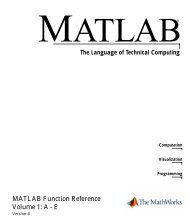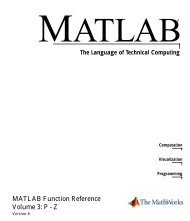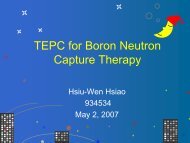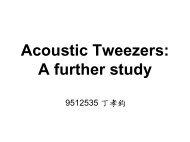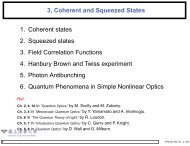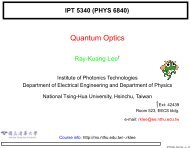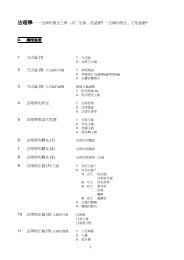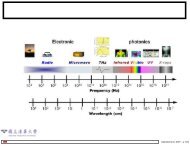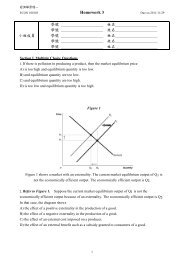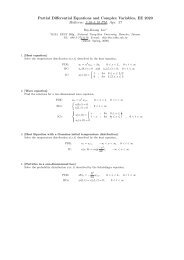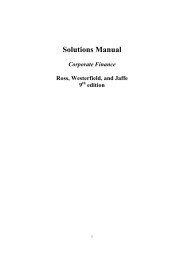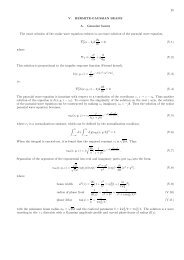Kun-I Lin, Li-Wu Chiang, Chien-Hung Wu, Shao-Wei Chen, Chung ...
Kun-I Lin, Li-Wu Chiang, Chien-Hung Wu, Shao-Wei Chen, Chung ...
Kun-I Lin, Li-Wu Chiang, Chien-Hung Wu, Shao-Wei Chen, Chung ...
You also want an ePaper? Increase the reach of your titles
YUMPU automatically turns print PDFs into web optimized ePapers that Google loves.
Note<br />
Synthesis of 5-Radioiodoarabinosyl Uridine Analog for Probing the HSV-1<br />
Thymidine Kinase Gene<br />
<strong>Kun</strong>-I <strong><strong>Li</strong>n</strong> a,b ( ), <strong>Li</strong>-<strong>Wu</strong> <strong>Chiang</strong> a ( ), <strong>Chien</strong>-<strong>Hung</strong> <strong>Wu</strong> a ( ),<br />
<strong>Shao</strong>-<strong>Wei</strong> <strong>Chen</strong> a ( ) and <strong>Chung</strong>-Shan Yu a *( )<br />
a Department of Nuclear Science, National Tsing-Hua University, No. 101, Sec. 2, Guang-Fu Road,<br />
Hsinchu 300, Taiwan, R.O.C.<br />
b Chang Bing Memorial Hospital, No. 6, Lu-Gung Road, Chang-Hua County 505, Taiwan, R.O.C.<br />
Tumor cells transduced with herpes simplex virus thymidine kinase gene have been intensively applied<br />
to the field of positron emission tomography via imaging of its substrate. As a pilot synthesis approach,<br />
a facile preparation of 5-[ 125 I]iodoarabinosyl uridine starting from commercially available uridine<br />
is reported herein.<br />
Keywords: HSV-1 TK; Cancer; Arabinosyl uridine; Stannane; Radioiodine.<br />
There is an increasing demand for radioiodo labeled<br />
nucleosides for the imaging of herpes simplex virus thymidine<br />
kinase (HSV-1 TK) transfected cancerous cells in<br />
cancer gene therapy research. 1-4 Briefly, the cancer lesion is<br />
first marked by the HSV-1 TK encoded gene, followed by<br />
the introduction of a non-toxic prodrug which is commonly<br />
a nucleoside analog. On entering the intracellular milieu,<br />
the prodrug can be phosphorylated by the cellular enzyme<br />
and forms a toxic metabolite which can lead to the premature<br />
termination of DNA replications, referred to as the suicide<br />
mechanism. 5-8 To achieve an optimized therapeutic effect,<br />
understanding of the localization where this event occurs<br />
using a tagged nucleoside analog is necessary. Furthermore,<br />
the assessment of gene expression levels of HSV-1<br />
TK in animal models has been successfully quantified by<br />
using positron emission tomography (PET). 9,10 Among the<br />
positron emitters used, 124 I is a typical choice for PET applications<br />
with an adequate half-life of 4.0 days and its adequate<br />
positron content: 25% for one decay. So far, several<br />
compounds, including [ 124 I]FIAU, have been developed<br />
as powerful tools in PET studies (Scheme I). 11-13<br />
As part of our systematic syntheses of radiolabeled<br />
thymidine analogs, 14-20 we have accomplished the facile<br />
preparation of [ 125 I]IaraU and [ 125 I]IVAU via iododestannylation<br />
with iodine under oxidation. 21-27 Whereas the instability<br />
that arose from the unexpected chelating effect of<br />
Journal of the Chinese Chemical Society, 2007, 54, 563-568 563<br />
Scheme I Potential probes for HSV-1 TK<br />
* Corresponding author. Tel: +886-3-5751922; Fax: +886-3-5718649; E-mail: csyu@mx.nthu.edu.tw<br />
5-trimethylstannyl group was addressed, excellent radiochemical<br />
yield was still available. 15 Herein we wish to report<br />
the preparation of the tin compound (Scheme II). The<br />
whole synthesis starts either from the commercial uridine 1<br />
or 2,2-cyclouridine 2. The epoxide ring can be mildly<br />
opened to generate a product 3 with a hydroxyl group with<br />
‘up’ configuration. Although similar reactions were mostly<br />
reported by using alkaline conditions, 28-29 we could accomplish<br />
this step under acidic conditions with dilute TFA. 1 Hand<br />
13 C-NMR data as well as the melting point of this product<br />
matched those of commercial araU 3. To avoid complication<br />
while introducing the stannan in the following step,<br />
the hydroxyl groups were protected by acetyl groups even<br />
though the later iodination could be done either with or<br />
without protection. The stannylation was accomplished<br />
with a modest yield. The subsequent deprotection step to
564 J. Chin. Chem. Soc., Vol. 54, No. 2, 2007 <strong><strong>Li</strong>n</strong> et al.<br />
obtain the stannan precursor 7 was performed in the presence<br />
of NaOMe and further purified by chromatography.<br />
According to TLC estimation, approximately 60% of compound<br />
7 was successfully recovered. To prevent the deteriorative<br />
fate of the tin compound, the whole deprotection<br />
process was performed at 0 C. Unfortunately, satisfactory<br />
spectra from ESI-MS spectra were not available for compound<br />
7 due to its extremely vulnerable half-life. However,<br />
we were able to identify a major peak corresponding to the<br />
clustering of the desired product and a minor peak for<br />
destannan byproduct, araU 8.<br />
The radioiodination of the tin compound 7 was efficient<br />
and mild. Approximately 99% of radioactive Na[ 125 I]I<br />
was successfully converted into [ 125 I]IaraU 9, as shown in<br />
Scheme II Synthesis of 5-[ 125 I]IaraU<br />
the HPLC chromatogram (Fig. 1). Briefly, we have described<br />
the procedure for preparation of 5-trimethyl stannyl<br />
araU and its radiolabeling with [ 125 I]NaI. A preliminary result<br />
of radiolabeling with [ 124 I]NaI for imaging HSV-1<br />
TK-transduced tumor cells using PET-CT indicated a significant<br />
accumulation of [ 124 I]IaraU. The result will be published<br />
elsewhere.<br />
EXPERIMENTAL<br />
Fig. 1. HPLC chromatogram of 5-[ 125 I]IaraU 9.<br />
General Methods<br />
1 H- and 13 C-NMR spectra were recorded using 500<br />
MHz instruments. Mass spectra were obtained by ESI (elec-
Synthesis of 5-Radioiodoarabinosyl Uridine Analog J. Chin. Chem. Soc., Vol. 54, No. 2, 2007 565<br />
tron spray ionization) technique. Analytical thin layer<br />
chromatography (TLC) was performed using silica gel 60<br />
F254 precoated plates. Detection was examined by UV<br />
(254 nm) or heating with stain (5% p-Anisaldehyde, sulfuric<br />
acid, acetic acid, EtOH). Flash chromatography was<br />
performed using silica gel 60 (230-400 mesh).<br />
2 O-2-cyclouridine 2<br />
A mixture of uridine 1 (500 mg, 2.05 mmol), diphenyl<br />
carbonate (570 mg, 2.65 mmol, 1.3 eq), and NaHCO3 (10<br />
mg, 0.12 mmol, 0.059 eq) in DMF (1 mL) was stirred at 140<br />
o C for 100 min. Product 2 (Rf = 0.41) was observed in TLC<br />
(MeOH/CHCl3 1:4). The starting material 1 (Rf = 0.30)<br />
was consumed. After completion of the reaction, the solution<br />
was cooled to rt while precipitation occurred. The precipitate<br />
after washing with cold methanol was collected as<br />
a white solid. After concentration under reduced pressure,<br />
an offwhite powder (370 mg, 80%) was obtained. Mp:<br />
250-253 C. [lit. 30 , 244-246 C, lit. 31 , 238-244 C; commercial<br />
authentic sample: 248-251 C]. anal. C9H10N2O5, calcd:<br />
C 47.79, H 4.46, N 12.39; found: C 47.41, H 4.44, N 12.41;<br />
MW: 226.2, ESI+Q-TOF MS, M = 226.1 (m/z), [M+H] + =<br />
227.1, [M+Na] + = 249.0, [2M+H] + = 453.2, [2M+Na] + =<br />
475.2; 1 H-NMR (500 MHz, CD3OD): 3.45 (dd, J5a,4 =<br />
4.0, J5a,5b =12.0 Hz, 1H, H5a), 3.49 (dd, J5b,4 = 4.0, J5b,5a<br />
=12.0 Hz, 1H, H5b), 4.23 (dd, J4,5a = 4.0, J4,5b = 4.0 Hz,<br />
1H, H4), 4.54 (s, 1H, H3), 5.28 (d, J2,1 = 6.0 Hz, 1H, H2),<br />
6.05 (d, J5,6 = 7.5 Hz, 1H, H5), 6.37 (d, J1,2 = 6.0 Hz, 1H,<br />
H1), 7.82 (d, J6,5 = 7.5 Hz, 1H, H6).<br />
1-(-D-arabinofuranosyl)-pyrimidin-2,4(3H)-dione 3<br />
Cyclouridine 2 (500 mg, 2.23 mmol) was suspended<br />
with DMF (5 mL) followed by addition of TFA (70 mL,<br />
0.05 N). Upon stirring, the mixture became clear. The solution<br />
was stirred at 80 o C for 10 h. Product 3 (Rf = 0.46) was<br />
observed in TLC (MeOH/CHCl3 1:3). The starting material<br />
(Rf = 0.26) was consumed. After completion of the reaction,<br />
the solvent was reduced at 45 C under reduced pressure.<br />
The residue was purified by column chromatography<br />
with MeOH/CHCl3 1:3 to provide 3 as a white powder<br />
(95%, 510 mg). Mp: 209-216 C [lit. 32 , 209-211 C, lit. 33 ,<br />
210-215 C]. anal. C9H12N2O6, calcd: C 44.27, H 4.95, N<br />
11.47; found: C 43.13, H 5.01, N 11.08. anal. C9H12N2O6<br />
MW: 244.2, ESI+Q-TOF MS, M = 244.1 (m/z), [M+H] + =<br />
245.0, [M+Na] + = 267.1, [2M+H] + = 489.2, [2M+Na] + =<br />
511.2, [3M+Na] + = 755.2; 1 H-NMR (500 MHz, CD3OD):<br />
3.77 (dd, J5a,4 = 4.5, J5a,5b =12.0 Hz, 1H, H5a), 3.81 (dd,<br />
J5b,4 = 4.0, J5b,5a =12.0 Hz, 1H, H5b), 3.91 (ddd, J4,3 = 3.5,<br />
J4,5b = 4.0, J4,5a = 4.5 Hz, 1H, H4), 4.06 (dd, J3,2 = 3.0,<br />
J3,4 = 3.5 Hz, 1H, H3), 4.14 (dd, J2,3 = 3.0, J2,1 = 4.5 Hz,<br />
1H, H2), 5.64 (d, J5,6 = 8.1 Hz, 1H, H5), 6.12 (d, J1,2 = 4.5<br />
Hz, 1H, H1), 7.84 (d, J5,6 = 8.1 Hz, 1H, H6).<br />
1-(2,5-Tri-O-acetyl--D-arabinofuranosyl)-pyrimidin-2,4(3H)-dione<br />
4<br />
3 (500 mg, 2.05 mmol) was dissolved in pyridine (35<br />
mL) with stirring for 1 h. Acetic anhydride (11 mL) was<br />
added. The stirring was continued at rt for 30 min. Product<br />
4 (Rf = 0.46) was observed in TLC (acetone/n-hexane 1:1).<br />
The starting material (Rf = 0.08) was consumed. After<br />
completion of the reaction, the distilling solvent was removed<br />
under reduced pressure. The residue was purified by<br />
column chromatography with acetone/n-hexane 4:5 to provide<br />
4 (89%, 675 mg) as a white powder, Mp: 128-130 C<br />
[lit.10 32 , 128-130 C, lit. 34 , 129-130 C]. anal. C15H18N2O9,<br />
calcd: C 48.65, H 4.90, N 7.56; found: C 48.41, H 5.01, N<br />
7.54; MW: 370.3, ESI+ Q-TOF MS, M = 370 (m/z), [M+H] +<br />
= 371.1, [M+Na] + = 393.0, [2M+H] + = 741.1, [2M+Na] + =<br />
763.1.<br />
1-(2,3,5-Tri-O-acetyl--D-arabinofuranosyl)-5-iodopyrimidin-2,4(3H)-dione<br />
5<br />
A mixture of 4 (454 mg, 1.23 mmol), I2 (420 mg, 1.66<br />
mmol, 1.3 eq), and ceric(IV) ammonium nitrate (700 mg,<br />
1.27 mmol, 1 eq) in acetonitrile (15 mL) was stirred at 80<br />
C for 1 h. Product 5 (Rf = 0.54) was observed in TLC (acetone/n-hexane<br />
1:1). The starting material 4 (Rf = 0.46) was<br />
consumed. Upon completion of the iodination, cold EtOAc<br />
(100 mL), NaHSO3 (5%, 30 mL), and satd aq NaCl (30 mL)<br />
were added sequentially. The organic layer was collected<br />
and the aqueous layer was extracted with EtOAc. The combined<br />
organic extracts were washed with cold NaHSO3<br />
(5%) followed by satd NaCl (aq) and H2O. After treatment<br />
with Na2SO4, the filtrate was concentrated under reduced<br />
pressure. The residue was purified by column chromatography<br />
with acetone/n-hexane 2:3 to provide the product 5 in<br />
a yield of 70% (425 mg). White powder, Mp: 184-186 C<br />
[lit. 35 , 185-187 C, lit. 36 , 184-186 C]. anal. C15H17IN2O9,<br />
calcd: C 36.31, H 3.45, N 5.65; found: C 36.09, H 3.52, N<br />
5.85. anal. C15H17IN2O9, MW: 496.2, ESI+Q-TOF, M =<br />
496.0 (m/z), [M+H] + = 497.0, [M+Na] + = 519.0, [2M+H] +<br />
= 993.0; 1 H-NMR (500 MHz, CDCl3): 2.04 (s, 3H, HAc),<br />
2.13 (s, 3H, HAc), 2.17 (s, 3H, HAc), 4.19 (ddd, J4,3 = 3.5,<br />
J4,5a = 4.5, J4,5b = 5.5 Hz, 1H, H4), 4.38 (dd, J5a,4 = 4.5,
566 J. Chin. Chem. Soc., Vol. 54, No. 2, 2007 <strong><strong>Li</strong>n</strong> et al.<br />
J5a,5b =12.0 Hz, 1H, H5a), 4.44 (dd, J5b,4 = 5.5, J5b,5a =<br />
12.0 Hz, 1H, H5b), 5.10 (dd, J3,2 = 1.5, J3,4 = 3.5 Hz, 1H,<br />
H3), 5.38 (dd, J2,3 = 1.5, J2,1 = 4.0 Hz, 1H, H2), 6.27 (d,<br />
J1,2 = 4.0 Hz, 1H, H1), 7.89 (s, 1H, H6), 8.87 (s, 1H, HNH).<br />
1-(2,3,5-Tri-O-acetyl--D-arabinofuranosyl)-5-trimethylstannyl<br />
pyrimidin-2,4(3H)-dione 6<br />
A mixture of 5 (600 mg, 1.21 mmol), hexamethylditin<br />
(1.42 g, 4.32 mmol, 3.6 eq), bis(triphenylphosphine)palladium<br />
dichloride (22 mg, 0.03 eq), and 1,4-dioxane (36 mL)<br />
was stirred at 100 C for 2 h. Product 6 (Rf = 0.65) was observed<br />
in TLC (acetone/n-hexane 1:1). 5 (Rf = 0.54) was<br />
consumed. Upon completion, the distilling solvent was removed<br />
at 45 C under reduced pressure. The residue was<br />
purified by column chromatography with EtOAc/n-hexane<br />
1:1 to provide 6 in a yield of 75% (500 mg). White waxy<br />
solid, Mp: 63-73 C. anal. C18H26N2O9Sn, calcd: C 40.55,<br />
H 4.92, N 5.25; found: C 42.36, H 5.79, N 5.01. MW:<br />
533.1, ESI+Q-TOF MS, M = 532.1 (m/z), [M+H] + = 533.1,<br />
[M+Na] + = 555.1. Clustering of the peaks corresponding to<br />
isotope distribution of Sn was observed; 1 H-NMR (500<br />
MHz, C6D6): 0.22-0.35 (m, 9H, SnMe3), 1.47 (s, 3H,<br />
HAc), 1.48 (s, 3H, HAc), 1.69 (s, 3H, HAc), 3.81 (ddd, J4,3 =<br />
3.5, J4,5a = 4.0, J4,5b = 6.5 Hz, 1H, H4), 4.24 (dd, J5a,4 =<br />
4.0, J5a,5b = 12.0 Hz, 1H, H5a), 4.32 (dd, J5b,4 = 6.5, J5b,5a<br />
= 12.0 Hz, 1H, H5b), 5.06 (dd, J3,2 = 1.0, J3,4 = 3.5 Hz, 1H,<br />
H3), 5.48 (dd, J2,3 = 1.0, J2,1 = 5.5 Hz, 1H, H2), 6.35 (d,<br />
J1,2 = 5.5 Hz, 1H, H1), 7.28-7.38 (m, 1H, H6), 9.76 (s, 1H,<br />
HNH). 13 C-NMR (125.70 MHz, C6D6): -9.44 (CH3Sn),<br />
19.84 (CH3CO), 19.92 (CH3CO), 20.32 (CH3CO), 62.54<br />
(CH2, C-5), 75.08 (CH), 76.59 (CH), 80.76 (CH), 84.78<br />
(CH), 111.43 (C-5), 144.09 (C-6), 150.91 (C=O, C-2),<br />
166.38 (C=O, C-4), 168.19 (CH3CO), 169.35 (CH3CO),<br />
169.84 (CH3CO).<br />
1-(-D-arabinofuranosyl)-5-trimethylstannylpyrimidin-<br />
2,4(3H)-dione 7 + 1-(-D-arabinofuranosyl)-pyrimidin-<br />
2,4(3H)-dione 8<br />
Starting material 6 (250 mg, 0.45 mmol) was dissolvedinMeOH(15mL)at0C.<br />
NaOMe/MeOH (5 mL,<br />
0.01 N) was added and stirring continued for 7 h. The formation<br />
of product 7 (Rf = 0.55) and decomposed byproduct,<br />
1-(-D-arabinofuranosyl)-pyrimidin-2,4(3H)-dione 8<br />
(Rf = 0.24), was detected by TLC (MeOH/CHCl3 1:4). After<br />
the starting materials 6 (Rf = 0.93) have been completely<br />
consumed, the reaction was neutralized by cation exchange<br />
resin (Dowex 500 WX8-400, H + form) and filtered. The<br />
eluent was concentrated under reduced pressure at 30 C<br />
yielding ~ 80% (140 mg) of product 7 with minor byproduct<br />
8. C12H20N2O6Sn calcd mass: 406.0 amu, ESI+Q-TOF<br />
MS, M(7) = 406.0 (m/z), [M+H] + = 407.1; M(8) = 244.1<br />
(m/z), [M+H] + = 245.1, [M+Na] + = 267.1, [2M+H] + =<br />
489.2; Clustering of the peaks corresponding to isotope distribution<br />
of Sn was observed. 1 H-NMR (500 MHz, CD3OD):<br />
0.24 (t, SnMe3, 7), 3.74-3.84 (m, H5, 7+8), 3.88-3.93 (m,<br />
H4, 7+8), 4.06 (pt, J = 3.5 Hz, H3, 8), 4.10 (pt, J = 3.5 Hz,<br />
H3, 7), 4.14-4.17 (m, H3, 7+8), 5.64 (d, J5,6 = 8.0 Hz, H5,<br />
8), 6.12 (d, J1,2 = 4.5 Hz, H1, 8), 6.17 (d, J1,2 = 4.5 Hz, H1,<br />
7), 7.64 (s, H6, 7), 7.84 (d, J6,5 = 8.0 Hz, H6, 8).<br />
1-(-D-arabinofuranosyl)-5-[ 125 I]iodopyrimidin-2,4(3H)dione<br />
9<br />
Tin compound 7 (500 g) was added to a microcentrifuge<br />
tube (1.5 mL) containing CHCl3 (400 L). Na[ 125 I]I (5<br />
10 4 cpm/10 L) in NaOH (800 L, 0.1 N) was added to<br />
the above mixture followed by a solution mixture of acetic<br />
acid (200 L) and hydrogen peroxide (30%) with a ratio of<br />
1:3 (v/v). The whole reaction mixture was sonicated for 1<br />
min and applied onto HPLC for analysis. Agilent HPLC<br />
was equipped with a sample loop (20 L), an analytical column<br />
[4.6 150 mm ZORBAR Eclipse XDB-C8 (5 mmaterial)],<br />
and UV detector setting at 260 nm. The fractions<br />
collected from the UV detector were counted for liquid<br />
scintillation on a 96 well microtiter plate reader (Plate<br />
CHAMELEON TM ). Time delay between UV signal and radioactivity<br />
was calibrated in the chromatogram. The eluent<br />
used was 0.5 mM Na3PO4/H3PO4 (pH = 5.7), with a flow<br />
rate of 1 mL/min. More than 99% of the radioactivity in the<br />
radiochromatogram was obtained as a single peak, corresponding<br />
to that of IaraU 9 (tR = 14.47 min). No further radioactivity<br />
was detected between 20 and 40 min when<br />
MeOH was set as isocratic auxiliary component from 0 to<br />
30%.<br />
Nonradioactive 1-(-D-arabinofuranosyl)-5-iodopyrimidin-2,4(3H)-dione<br />
9<br />
5 (500 mg, 1.0 mmol) was dissolved in MeOH (8 mL)<br />
with stirring at rt and NaOMe/MeOH (5 mL, 0.5 N, 2.5 eq)<br />
was added. The stirring was continued for 30 min. 9 (Rf =<br />
0.17) was observed in TLC (MeOH/CHCl3 1:9). 6 (Rf =<br />
0.85) was consumed. After completion of the reaction, the<br />
solution was neutralized by cation exchange (Dowex 500<br />
WX8-400, H + form). The volatiles were evaporated under<br />
reduced pressure at 40 C. Yield of 9 was 80% (300 mg).
Synthesis of 5-Radioiodoarabinosyl Uridine Analog J. Chin. Chem. Soc., Vol. 54, No. 2, 2007 567<br />
Mp: 224-226 C , [lit. 37 , 224-227C], C9H11IN2O6, calcd: C<br />
29.21, H 3.00, N 7.57; found: C 29.09, H 3.40, N 7.32. anal.<br />
C9H11IN2O6, MW: 370.1, ESI+Q-TOF MS, M = 370.0<br />
(m/z); [M+H] + = 371.1, [M+NH4] + = 388.0, [M+Na] + =<br />
393.0, [2M+H] + = 741.0, [2M+NH4] + = 758.1, [2M+Na] + =<br />
763.0, [3M+NH4] + = 1128.1, [3M+Na] + = 1133.0; 1 H-<br />
NMR (500 MHz, CD3OD): 3.77 (dd, J5a,4 = 4.5, J5a,5b =<br />
12.0 Hz, 1H, H5a), 3.83 (dd, J5b,4 = 4.0, J5b,5a = 12.0 Hz,<br />
1H, H5b), 3.90 (ddd, J4,3 = 3.5, J4,5b = 4.0, J4,5a = 4.5 Hz,<br />
1H, H4), 4.06 (dd, J3,2 = 3.0, J3,4 = 3.5 Hz, 1H, H3), 4.14<br />
(dd, J2,3 = 3.0, J2,1 = 4.5 Hz, 1H, H2), 6.10 (d, J1,2 = 4.5<br />
Hz, 1H, H1), 8.27 (s, 1H, H6).<br />
ACKNOWLEDGMENTS<br />
We thank the National Science Council, Taiwan, for<br />
the support of this work (NSC-94-2113-M-007-005).<br />
Received June 19, 2006.<br />
REFERENCES<br />
1. Peñuelas, I.; Boán, J. F.; Martý-Climent, J. M.; Sangro, B.;<br />
Mazzolini, G.; Prieto, J.; Richter, J. A. Mol. Imaging Biol.<br />
2004, 6, 225-238.<br />
2. Herschman, H. R. Crit. Rev. Oncol. Hemat. 2004, 51, 191-<br />
204.<br />
3. Herschman, H. R. J. Cell. Biochem. Suppl. 2002, 39, 36-44.<br />
4. Advani1, S. J.; <strong>Wei</strong>chselbaum, R. R.; Whitley, R. J.;<br />
Roizman, B. Clin. Microbiol. Infec. 2002, 8, 551-563.<br />
5. deVries, E. F. J.; Buursma, A. R.; Hospers, G. A. P.; Mulder,<br />
N. H.; Vaalburg, W. Curr. Pharm. Design 2002, 8, 1435-<br />
1450.<br />
6. Gambhir, S. S.; Herschman, H. R.; Cherry, S. R. Neoplasia<br />
2000, 2, 118-138.<br />
7. Nichol, C.; Kim, E. E. J. Nucl. Med. 2001, 42, 1368-1374.<br />
8. Gibson, R. E.; Burns, H. D.; Hamill, T. G.; Eng, W. S.; Francis,<br />
B. E.; Ryan, C. Curr. Pharm. Design 2000, 6, 973-989.<br />
9. Verel, I.; Visser, G. W. M.; Vosjan, M. J. W. D.; Finn, R.;<br />
Boellaard, R.; van Dongen, G. A. M. S. Eur. J. Nuc. Med.<br />
Mol. Imaging 2004, 31, 1645-1652.<br />
10. Green, L. A.; Nguyen, K.; Berenji, B.; Iyer, M.; Bauer, E.;<br />
Barrio, J. R.; Namavari, M.; Satyamurthy, N.; Gambhir, S. S.<br />
J. Nucl. Med. 2004, 45, 1560-1570.<br />
11. Simoes, M. V.; Miyagawa, M.; Reder, S.; Stadele, C.;<br />
Haubner, R.; <strong><strong>Li</strong>n</strong>ke, W.; Lehner, T.; Epple, P.; Anton, M.;<br />
Schwaiger, M.; Bengl, F. M. J. Nucl. Med. 2005, 46, 98-105.<br />
12. Soghomonyan, S. A.; Doubrovin, M.; Pike, J.; Luo, X.;<br />
Ittensohn, M.; Runyan, J. D.; Balatoni, J.; Finn, R.; Tjuvajev,<br />
J. G.; Blasberg, R.; Bermudes, D. Cancer Gene Ther. 2005,<br />
12, 101-108.<br />
13. Wen, B. X.; Burgman, P.; Zanzonico, P. J.; O’Donoghue, J.;<br />
Cai, S. D.; Finn, R.; Serganova, I.; Blasberg, R.; Gelovani, J.;<br />
<strong>Li</strong>, G. C.; <strong><strong>Li</strong>n</strong>g, C. C. Eur. J. Nucl. Med. Mol. Imaging 2004,<br />
31, 1530-1538.<br />
14. Yu, C.-S.; <strong>Chiang</strong>, L.-W.; <strong>Wu</strong>, C.-H.; Hsu, Z-K.; Lee, M.-H.;<br />
Pan, S.-D.; Pei, K. Synthesis 2006, 3835-3840.<br />
15. Yu, C.-S.; <strong>Chiang</strong>, L.-W.; <strong>Wu</strong>, C.-H.; Wang, R.-T.; <strong>Chen</strong>,<br />
S.-W.; Wang, H.-Y.; Yeh, C.-H. Nucl. Med. Biol. 2006, 33,<br />
367-370.<br />
16. Yu, C.-S.; <strong>Wu</strong>, C.-H.; <strong>Chiang</strong>, L.-W.; Wang, R.-T; Wang,<br />
H.-Y.; Yeh, C.-H.; <strong><strong>Li</strong>n</strong>, K.-I. Chem. Lett. 2005, 34, 1390-<br />
1391.<br />
17. Yu, C.-S.; Eisenbarth, J.; Runz, A.; Weber, K.; Zeisler, S.;<br />
Oberdorfer, F. J. Label Compd. Radiopharm. 2003, 46,<br />
421-439.<br />
18. Yu, C.-S.; Oberdorfer, F. Nucleos. Nucleot. Nucl. 2003, 22,<br />
71-84.<br />
19. Yu, C.-S.; Oberdorfer, F. Synlett 2000, 86-88.<br />
20. Yu, C.-S.; Oberdorfer, F. Synthesis 1999, 2057-2064.<br />
21. Kusumoto, S.; Fukase, K.; Oikawa, M.; Suda, Y. J. Chin.<br />
Chem. Soc. 2002, 49(4), 453-458.<br />
22. <strong>Li</strong>ang, P. H.; Hsin, L. W.; Pong, S. L.; Hsu, C. H.; <strong>Chen</strong>g, C.<br />
Y. J. Chin. Chem. Soc. 2003, 50(3A), 449-456.<br />
23. Ho, T. L.; Chein, R. J. J. Chin. Chem. Soc. 2006, 53(2),<br />
429-430.<br />
24. Kuo, C. Y.; <strong>Wu</strong>, M. J. J. Chin. Chem. Soc. 2005, 52(5),<br />
965-974.<br />
25. Rehman, W.; Baloch, M. K.; Badshah, A. J. Chin. Chem.<br />
Soc. 2005, 52(2), 231-236.<br />
26. Rehman, W.; Badshah, A.; Baloch, M. K. J. Chin. Chem.<br />
Soc. 2004, 51(5A), 929-934.<br />
27. Wang, E. C.; <strong>Chen</strong>, H. Y.; Tzeng, C. C. J. Chin. Chem. Soc.<br />
1993, 40(1), 73-79.<br />
28. Ozaki, H.; Nakajima, K.; Tatsui, K.; Izumi, C.; Kuwahara,<br />
M.; Sawai, H. Bioorg. Med. Chem. Lett. 2003, 13, 2441-<br />
2443.<br />
29. Wnuk, S. F.; Chowdhury, S. M.; Garcia, J. P. I.; Robins, M. J.<br />
J. Org. Chem. 2002, 67, 1816-1819.<br />
30. Schinazi, R. F.; <strong>Chen</strong>, M. S.; Prusoff, W. H. J. Med. Chem.<br />
1979, 22, 1273-1277.<br />
31. Hampton, A.; Nichol, A.W. Biochemistry 1966, 5, 2076.<br />
32. Pankiewicz, K. W.; Watanabe, K. A. Chem. Pharm. Bull.<br />
1987, 35, 4494-4497.<br />
33. Codington, J. F.; Fecher, R.; Fox, J. J. J. Am. Chem. Soc.
568 J. Chin. Chem. Soc., Vol. 54, No. 2, 2007 <strong><strong>Li</strong>n</strong> et al.<br />
1960, 82, 2794-2803.<br />
34. <strong><strong>Li</strong>n</strong>, T.-S.; Gao, Y. S. J. Med. Chem. 1983, 26, 598-601.<br />
35. Robin, M. J.; Manfredini, S.; Wood, S. G.; Wanklin, R. J.;<br />
Rennie, B. A.; Sacks, S. L. J. Med. Chem. 1991, 34, 2275-<br />
2280.<br />
36. Brown, D. M.; Todd, A.; Varadarajan, S. J. Chem. Soc. 1966,<br />
2388.<br />
37. Ono, K.; Ogasawara, M.; Ohashi, A.; Matsukage, A.;<br />
Takahashi, T.; Nakayama, C.; Saneyoshi, M. Biochemistry<br />
1982, 21, 1019-1024.



